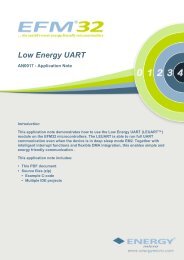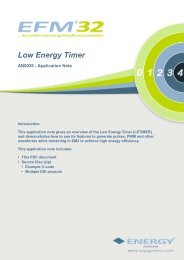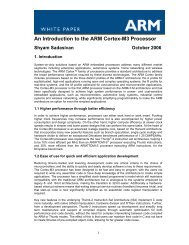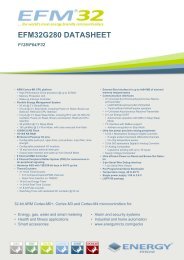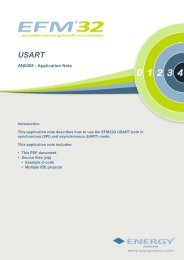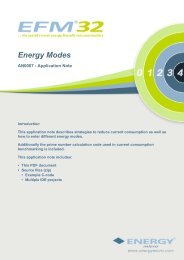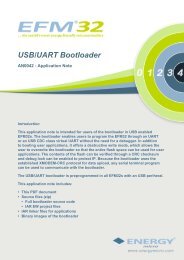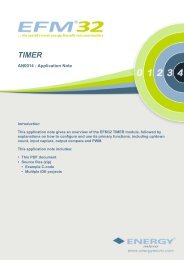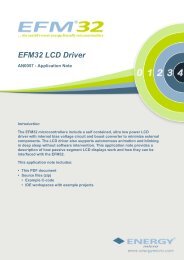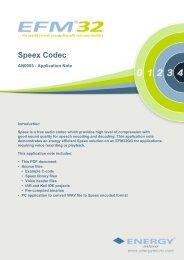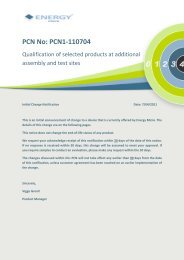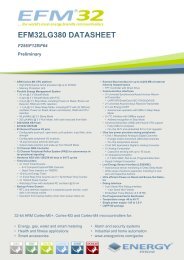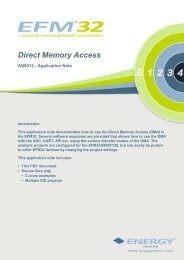EFM32 Debug and Trace - AN0043 - Application Note - Energy Micro
EFM32 Debug and Trace - AN0043 - Application Note - Energy Micro
EFM32 Debug and Trace - AN0043 - Application Note - Energy Micro
Create successful ePaper yourself
Turn your PDF publications into a flip-book with our unique Google optimized e-Paper software.
1 Introduction...the world's most energy friendly microcontrollersThe <strong>EFM32</strong> microcontrollers use the ARM CoreSight TM on-chip debug <strong>and</strong> trace interface. Serial Wire<strong>Debug</strong> technology (SWD), specifically the Serial Wire <strong>Debug</strong> Port (SW-DP) for the <strong>EFM32</strong>, is used asthe interface between the on-chip debug module <strong>and</strong> the development environment on a computer. SW-DP is a 2-pin debug interface which offers a high performance <strong>and</strong> low pin count alternative to JTAG.SWD is often used as an acronym for both the SW-DP <strong>and</strong> SWJ-DP (Serial Wire JTAG <strong>Debug</strong> Port).The <strong>EFM32</strong> does not implement SWJ-DP.All <strong>EFM32</strong> devices also include the Serial Wire Output interface which is a one wire interface for theInstrumentation <strong>Trace</strong> Macrocell (ITM) which is a CoreSight module that provides coarse-grained timestamping <strong>and</strong> software driven trace information.Some device families, including Leopard Gecko, Giant Gecko <strong>and</strong> Wonder Gecko devices also includethe CoreSight Embedded <strong>Trace</strong> Macrocell (ETM). This module provides full instruction trace over aseparate high speed trace interface. Instruction trace allows the software developer to get a morecomplete view of what goes on inside the microcontrollers CPU.2013-05-08 - an0043_Rev1.02 2 www.energymicro.com
2 <strong>EFM32</strong> <strong>Debug</strong> <strong>and</strong> <strong>Trace</strong> System...the world's most energy friendly microcontrollersAn overview of all the different modules that makes up the CoreSight system inside the <strong>EFM32</strong> is givenin Figure 2.1 (p. 3) . A short description of the different modules are given in the following section.Figure 2.1. <strong>Debug</strong> OverviewFPBChip boundaryDWT4 watchpointsPC sam pler*ETM triggerInterrupt trace6 breakpointsITMSoftware trace32 channelsTim e stam pingDAPLivecore accessSW-DPTPIUSWO21CPU statisticsETM*<strong>Trace</strong> port5*Instructiontrace* ETM Optional2.1 Serial Wire <strong>Debug</strong> Port (SW-DP)The SW-DP provides a low pin count bi-directional serial connection to the <strong>Debug</strong> Access Port (DAP) witha reference clock signal for synchronous operation. This is the only connection from outside the <strong>EFM32</strong>to access core registers <strong>and</strong> memory within the MCU. Through this two wire interface the debuggerhas real-time access to system/peripheral memory <strong>and</strong> debug configuration registers. Access is evenavailable without halting the processor.The communication over the SW-DP uses a three phase protocol:• A host-to-target packet request.• A target-to-host acknowledge response.• A data transfer phase, if required. This can be target-to-host or host-to-target, depending on therequest made in the first phase.More information on the CoreSight Serial Wire <strong>Debug</strong> interface <strong>and</strong> protocol can be found here:• http://infocenter.arm.com/help/topic/com.arm.doc.ddi0314h/DDI0314H_coresight_components_trm.pdf• http://infocenter.arm.com/help/index.jsp?topic=/com.arm.doc.ddi0314h/Babcfacj.html2.2 Instrumentation <strong>Trace</strong> Macrocell (ITM)The ITM is a an application-driven trace source that supports printf() style debugging to trace operatingsystem <strong>and</strong> application events. The ITM is responsible for generating packets based on informationfrom multiple sources. Software can write directly to ITM stimulus registers to generate packets. TheData Watchpoint <strong>and</strong> <strong>Trace</strong> (DWT) module can also generate packets that are formatted <strong>and</strong> output by2013-05-08 - an0043_Rev1.02 3 www.energymicro.com
...the world's most energy friendly microcontrollersthe ITM. Finally the ITM can generate timestamps using the 21 bit counter within the ITM module. Thepackets generated are sent out over the Serial Wire Output (SWO) interface.2.3 Serial Wire Output (SWO)The Serial Wire Output module formats <strong>and</strong> sends the data from the ITM over a one wire connection tothe debugger. Typically data is transmitted in bytes with either a Manchester or UART protocol.2.4 Embedded <strong>Trace</strong> Macrocell (ETM)The ETM module provides full instruction trace for the CPU. Data transferred through the <strong>Trace</strong> PortInterface Unit (TPIU), can be reconstructed to full program execution. Reconstruction, typically by debugsoftware running on a computer, results in cycle accurate execution history for parts of the code. Theamount of trace data captured depends on the trace buffer size in the debugger.2.5 Data Watchpoint <strong>and</strong> <strong>Trace</strong> (DWT)The data watchpoint <strong>and</strong> trace unit contains several comparators <strong>and</strong> counters that can be configuredto generate events for the ITM <strong>and</strong> ETM modules. The most common features include data breakpoints,data/interrupt triggers <strong>and</strong> PC (Program Counter) sampling. This module, combined with the ITM canperform low-b<strong>and</strong>width data trace.2.6 Flash Patch <strong>and</strong> Breakpoint unit (FPB)This module consist of several address matching tags. When a match occurs the access can be reroutedfrom flash to a special part of the SRAM. This permits patching flash locations for breakpointing <strong>and</strong>quick fixes or changes. This is the unit that h<strong>and</strong>les hardware breakpoints for code.More information on the different CoreSight components can be found in the Cortex-M3 TechnicalReference Manual from ARM:• http://infocenter.arm.com/help/topic/com.arm.doc.ddi0337i/DDI0337I_cortexm3_r2p1_trm.pdf2013-05-08 - an0043_Rev1.02 4 www.energymicro.com
3 <strong>Debug</strong> Connection with SW-DP...the world's most energy friendly microcontrollersSW-DP is a packet based protocol with a unidirectional clock signal <strong>and</strong> a bi-directional data signal.The master, which is usually the debugger, drives the clock signal. Both master <strong>and</strong> slave can drivethe data-line.3.1 Serial Wire Hardware ConnectionThe minimum hardware connection needed for full debug functionality is illustrated in Figure 3.1 (p.5) .Figure 3.1. Minimum serial wire debug connection.VMCUVMCUVDDPF1PF0PF2 or PC15OptionalSWDIOSWCLKSWOVtarget*1 23 45 67 89 10RESETnReset11 12VSS13 1415 1617 18<strong>EFM32</strong>19 20*Vtarget is not a power supply, it is needed for level shifterreference <strong>and</strong> Vtarget m easurem ent.ARM 20 Pin HeaderMake sure that the debug lines are kept short. Especially the chip unlock feature of the <strong>EFM32</strong> relieson high speed communication over the serial wire debug interface. The Serial Wire Output (SWO) lineis optional <strong>and</strong> not needed for plain code uploading <strong>and</strong> stop/go debugging, but it is needed for themore advanced features such as instrumentation trace. The reset signal is also optional, but highlyrecommended. Without it, the <strong>EFM32</strong> lock/unlock feature will not work <strong>and</strong> it can be difficult to accessthe chip if the code for some reason disables clocks or debug pins etc.For a detailed description of the hardware design considerations for the <strong>EFM32</strong>, please see applicationnote AN0002 <strong>EFM32</strong> Hardware Design Considerations.3.2 <strong>Debug</strong>ging with the <strong>Energy</strong> <strong>Micro</strong> KitsBoth the <strong>Energy</strong> <strong>Micro</strong> starter kits <strong>and</strong> development kits include a full featured Segger J-Link TM debuginterface to take full advantage of the serial wire debug features of the <strong>EFM32</strong> microcontrollers (SW-DP<strong>and</strong> SWO). The kits can be configured to debug either the <strong>EFM32</strong> part mounted on the kit itself, or it canbe used to program <strong>and</strong> debug an <strong>EFM32</strong> mounted on your own board. As long as you are working with<strong>EFM32</strong> microcontrollers, you do not need any other debug adapter.<strong>Note</strong>Not all of the <strong>Energy</strong> <strong>Micro</strong> kits include a full J-<strong>Trace</strong> enabled debugger (needed for ETMInstruction <strong>Trace</strong>). Please refer to the kit documentation for your kit.2013-05-08 - an0043_Rev1.02 5 www.energymicro.com
...the world's most energy friendly microcontrollers3.3 Software ToolsSoftware tools, typically in the form of an IDE (Integrated Development Environment) is needed to takefull advantage of the <strong>EFM32</strong>'s debug features. The following section describes how to set up a debugsessionwith one of our kits in combination with an IDE from either IAR or ARM (µVision IDE from Keil,from now on called referred to as Keil).3.3.1 Upload Code <strong>and</strong> <strong>Debug</strong> with Keil1. Make sure your kit is connected to the computer <strong>and</strong> correctly identified as a Segger J-Link device.Also make sure that the kit debug mode is configured correctly. You can use the <strong>Energy</strong> AwareComm<strong>and</strong>er to change debug mode <strong>and</strong> check if the J-Link can contact the target <strong>EFM32</strong> device.Figure 3.2 (p. 6) illustrates correct <strong>Energy</strong> Aware Comm<strong>and</strong>er output when the J-Link on thekit is working.Figure 3.2. eAcomm<strong>and</strong>er connected correctly to computer.2. In Keil, check that the project debug options <strong>and</strong> J-Link Target Driver options are configured correctly.See Figure 3.3 (p. 7) <strong>and</strong> Figure 3.4 (p. 7) .2013-05-08 - an0043_Rev1.02 6 www.energymicro.com
...the world's most energy friendly microcontrollersFigure 3.3. Keil debug options.Figure 3.4. Keil J-Link Target Driver options.3. Build target by right clicking project or pressing F7.2013-05-08 - an0043_Rev1.02 7 www.energymicro.com
...the world's most energy friendly microcontrollersFigure 3.5. Keil build target.4. Start the debug session by pressing Ctrl+F5.<strong>Note</strong>: If you have not selected the "Update Target before debugging" in the options->utilities menu,you have to upload any new code before starting the debug session.Figure 3.6. Keil start or stop debug session.5. You are now in a debug session, single stepping <strong>and</strong> other debug feature are available in the topleft corner.2013-05-08 - an0043_Rev1.02 8 www.energymicro.com
...the world's most energy friendly microcontrollersFigure 3.7. Keil in debug session.For more information regarding debugging in Keil uVision, please refer to the uVision documentation:• http://www.keil.com/product/brochures/uv4.pdf3.3.2 Upload Code <strong>and</strong> <strong>Debug</strong> with IAR1. Make sure your kit is connected to the computer <strong>and</strong> correctly identified as a Segger J-Link device.Also make sure that the kit debug mode is configured correctly. You can use the <strong>Energy</strong> AwareComm<strong>and</strong>er to change debug mode <strong>and</strong> check if the J-Link can contact the target <strong>EFM32</strong> device.Figure 3.2 (p. 6) illustrates correct <strong>Energy</strong> Aware Comm<strong>and</strong>er output when the J-Link on thekit is working.2. In IAR, check that the project options regarding debugger <strong>and</strong> J-Link are configured correctly. Seethe different screenshots below:2013-05-08 - an0043_Rev1.02 9 www.energymicro.com
Figure 3.8. IAR debugger setup settings....the world's most energy friendly microcontrollersFigure 3.9. IAR debugger download settings.2013-05-08 - an0043_Rev1.02 10 www.energymicro.com
...the world's most energy friendly microcontrollersFigure 3.10. IAR J-Link setup settings.Figure 3.11. IAR J-Link connection settings.3. Build target by selecting Make from the project-menu or pressing F7.2013-05-08 - an0043_Rev1.02 11 www.energymicro.com
...the world's most energy friendly microcontrollersFigure 3.12. IAR build project.4. Download code <strong>and</strong> start the debug session by the small green arrow or Ctrl+D. See screenshotPressing this button will also do a build if there are changes since the last build.Figure 3.13. IAR upload code <strong>and</strong> start debugging.5. You are now in a debug session, single stepping <strong>and</strong> other debug feature are available in the topleft corner.For more information regarding debugging in IAR, please refer to the IAR documentation:• ftp://ftp.iar.se/WWWfiles/arm/webic/doc/EWARM_<strong>Debug</strong>gingGuide.ENU.pdf3.4 Serial Wire OutputIn addition to the two SW-DP pins which allows normal debug operations <strong>and</strong> programming of the<strong>EFM32</strong>. The microcontroller also includes a SWO (Serial Wire Output) interface. SWO is a one wireoutput from the ITM (Instrumentation <strong>Trace</strong> Module), see Figure 2.1 (p. 3) . By having the software writingto the ITM-registers, data can be sent to the debugger through this one wire interface. This enablesdebug printf messages to be sent without setting up a separate serial output connection.The ITM also supports time stamping of events like interrupt h<strong>and</strong>ling <strong>and</strong> program counter samples. Thisenables simple code tracing <strong>and</strong> profiling. The b<strong>and</strong>width is not high enough to capture all the activity2013-05-08 - an0043_Rev1.02 12 www.energymicro.com
...the world's most energy friendly microcontrollersgoing on inside the CPU. Still time stamped samples of the program counter <strong>and</strong> interrupt execution canbe valuable information in a debug situation.3.4.1 SWO printf in IARThe following walk through demonstrates how to send Hello world through the SWO interface to theIAR IDE terminal output.1. Add #include to the beginning of the file where the printf statement is located.2. Enable the <strong>EFM32</strong> SWO Output.The simplest way of enabling the SWO line in the <strong>EFM32</strong> is by using the setupSWO function. Youcan find this function in the energyAware Profiler, in the left pane, when you open up the program.Once this is executed, the SWO output will be enabled on the correct pin for the Development Kitor Starter Kit.The content of the setupSWO function is also available as part of the board support package for eachkit. The software examples supplied with this application note includes the TRACE_SWOSetup()function from there which does the same thing as the setupSWO in the profiler.3. Configure the project in IAR to receive <strong>and</strong> transmit data through SWO:Figure 3.14. IAR project options for SWO printf.4. Write printf("Hello world"); in your code after you have enabled the SWO output.5. Compile the code <strong>and</strong> download it to the Starter Kit/Development Kit. Start the debug session.6. Once you are in debug mode, you should set the correct clock speed (14 MHz) <strong>and</strong> enable one ormore ITM ports in J-link->SWO Configuration, Figure 3.15 (p. 14) . Please note that the clock2013-05-08 - an0043_Rev1.02 13 www.energymicro.com
...the world's most energy friendly microcontrollersspeed is 14 MHz regardless of your core clock frequency. The debug clock is derived from theAUXHFRCO which runs at 14 MHz by default.Figure 3.15. SWO configuration in IAR.7. Open up View->Terminal I/O.8. When you hit Go you should see the printf statement show up as below:Figure 3.16. IAR terminal output.3.4.2 SWO printf in KeilThe following walk through demonstrates how to send Hello world through the SWO interface to theKeil IDE terminal output.1. Add #include to the beginning of the file where you want to write your printf statement.2. Enable SWO Output.The simplest way of enabling the SWO line in the <strong>EFM32</strong> is by using the setupSWO function. Youcan find this function in the energyAware Profiler, in the left pane, when you open up the program.Once this is run, the SWO output will be enabled to the correct pin on the Development Kit or theStarter Kit.3. In the project options in Keil, go to the <strong>Debug</strong> tab <strong>and</strong> Press the Settings button next to the debuggerselection (Should say Cortex-M/R J-LINK/J-<strong>Trace</strong>). Go to the <strong>Trace</strong> tab <strong>and</strong> check the Enable boxas well as setting Core Clock to 14 MHz <strong>and</strong> the Prescaler under SWO Settings to Core Clock /16. Please note that the clock speed is 14 MHz regardless of your core clock frequency. The debugclock is derived from the AUXHFRCO which runs at 14 MHz by default.2013-05-08 - an0043_Rev1.02 14 www.energymicro.com
Figure 3.17. Keil debugger options for SWO printf....the world's most energy friendly microcontrollers4. Write printf("Hello world"); in your code after you have enabled the SWO output.5. To enable the ARM compiler to send printf comm<strong>and</strong>s through the SWO interface you need to addthe following lines to your code:struct __FILE { int h<strong>and</strong>le; /* Add whatever you need here */ };FILE __stdout;FILE __stdin;int fputc(int ch, FILE *f) {ITM_SendChar(ch);return(ch);}6. Compile the code <strong>and</strong> download it to the Starter Kit/Development Kit. Enter a debug session.7. Open the printf-viewer by going to View->Serial Windows-><strong>Debug</strong> (printf) Viewer8. When you hit Run you should see the printf statement show up as below:Figure 3.18. Keil terminal output.2013-05-08 - an0043_Rev1.02 15 www.energymicro.com
3.5 Alternative Capture of SWO Output...the world's most energy friendly microcontrollersThe software trace data transmitted by the printf function, or by other means through the SWO-output,must not necessarily be read in a terminal window within the IDE itself. Some debuggers supportreading the SWO output directly in a separate terminal window. The <strong>Energy</strong> Aware Comm<strong>and</strong>er softwarefrom <strong>Energy</strong> <strong>Micro</strong> also supports reading printf SWO output directly with the comm<strong>and</strong> line feature '--readswo'.3.6 Other SWO-featuresThe Instrumentation <strong>Trace</strong> Module with SWO output can be used for several other features than printfdebugging. Some features include the Data Watchpoint <strong>and</strong> <strong>Trace</strong> module which can monitor the valueof variables. Time Stamping feature which is useful for measuring execution time of a piece of code<strong>and</strong> Interrupt <strong>Trace</strong> which gives information about interrupt execution <strong>and</strong> timing. Documentation <strong>and</strong>software examples for the other SWO features can be found in the IAR CoreSight application notereferred to in Section 5.4 (p. 22) .2013-05-08 - an0043_Rev1.02 16 www.energymicro.com
...the world's most energy friendly microcontrollers4 Full Instruction <strong>Trace</strong>Some device families, including Leopard Gecko, Giant Gecko <strong>and</strong> Wonder Gecko devices include theCoreSight Embedded <strong>Trace</strong> Macrocell (ETM). Through a separate 5 wire interface the ETM is a debugcomponent that enables full reconstruction of actual program execution. The ETM is designed to be ahigh-speed, but still low-power debug tool that supports instruction trace.4.1 Hardware ConnectionThe <strong>EFM32</strong>'s hardware connection for instruction trace normally uses 5 additional pins compared to the2 pins of the serial wire debug interface. Figure 4.1 (p. 17) illustrates the pinout of the connectorchosen on the development kits. It is a 1.27mm pitch 20 pin connector which is smaller than the st<strong>and</strong>ard2.54 debug connector. It includes both the normal debug interface <strong>and</strong> the instruction trace connection.No additional connector is needed for programming/debugging if the trace-connector is used.Figure 4.1. Typical 5 wire ETM trace connection.VMCUVMCUOptional 5VOptional 5VVtargetGNDGNDNCGNDGNDGND1 23 45 689 1011 1213 1415 1617 1819 20SWDIOSWCLKSWOTDIReset<strong>Trace</strong> clk<strong>Trace</strong> data 0<strong>Trace</strong> data 1<strong>Trace</strong> data 2<strong>Trace</strong> data 3PF1PF0PF2RESETnPD7PD6PD3PD4PD5VDDJ-Link 19-pin Cortex-Mdebug <strong>and</strong> ETM connectorVSS*Vtarget is not a power supply, it is needed for level shifterreference <strong>and</strong> Vtarget m easurem ent.<strong>EFM32</strong>4.2 ETM Instruction <strong>Trace</strong> SetupHow to start a debug session with ETM instruction trace enabled. Instructions given for both Keil <strong>and</strong> IAR.4.2.1 Instruction <strong>Trace</strong> in IAR1. If you are using the DK3650/3750 as J-<strong>Trace</strong>, make sure that ETM trace is enabled on the kit itself.This can only be configured through the kit CFG-menu on the TFT-display.2. Make sure your project includes the TRACE_ETMSetup() at startup. This enables the ETM traceinside the <strong>EFM32</strong> <strong>and</strong> also enables the correct GPIO-pins for trace to function on the development kit.<strong>Note</strong>: If you are using your own board with trace routed to other pins, please change this ETMSetupfunction accordingly.3. Start a debug session <strong>and</strong> then open the J-<strong>Trace</strong> window (J-Link -> ETM <strong>Trace</strong>), function trace canalso be opened from here. If trace is turned on the small ETM icon in the upper left corner shouldbe green. Clicking this will also open the trace settings.2013-05-08 - an0043_Rev1.02 17 www.energymicro.com
Figure 4.2. Open ETM <strong>Trace</strong> window in IAR....the world's most energy friendly microcontrollersFigure 4.3. ETM <strong>Trace</strong> settings in IAR.4. You are now in a debug session with instruction trace enabled. You can single step <strong>and</strong> should seeinstructions appear in the trace window.2013-05-08 - an0043_Rev1.02 18 www.energymicro.com
Figure 4.4. IAR instruction <strong>and</strong> function trace windows....the world's most energy friendly microcontrollers5. You can right click on a line of code <strong>and</strong> enable trace start/stop breakpoints, this is an importantfeature which helps to limit the amount of trace data when debugging a problem in a specific partof the code.Figure 4.5. IAR toggle breakpoints for trace start <strong>and</strong> trace stop.4.2.2 Instruction <strong>Trace</strong> in Keil1. If you are using the DK3650/3750 as J-<strong>Trace</strong>, make sure that ETM trace is enabled on the kit itself.This can only be configured through the kits CFG-menu on the kits own TFT-display.2013-05-08 - an0043_Rev1.02 19 www.energymicro.com
...the world's most energy friendly microcontrollers2. Make sure your project includes the TRACE_ETMSetup() at startup. This enables the ETM traceinside the <strong>EFM32</strong> <strong>and</strong> also enables the correct GPIO-pins for trace to function on the development kit.<strong>Note</strong>: If you are using your own board with trace routed to other pins, please change this ETMSetupfunction accordingly.3. Check that <strong>Trace</strong> is configured correctly in the Cortex Jlink/J<strong>Trace</strong> Target Driver Setup, note thatyou need to enable trace separately in the trace setup window.Figure 4.6. ETM trace settings in Keil.4. Start a debug session <strong>and</strong> then open the instruction trace window to see the trace data. (View -><strong>Trace</strong> -> Instruction <strong>Trace</strong>).2013-05-08 - an0043_Rev1.02 20 www.energymicro.com
Figure 4.7. Keil instruction trace window....the world's most energy friendly microcontrollers5. You are now in a debug session with instruction trace enabled. You can single step <strong>and</strong> should seeinstructions appear in the trace window.2013-05-08 - an0043_Rev1.02 21 www.energymicro.com
5 Software Examples...the world's most energy friendly microcontrollersThis application note includes software examples for both the Tiny Gecko <strong>and</strong> Giant Gecko <strong>EFM32</strong>microcontrollers. The software examples demonstrate how to configure the <strong>EFM32</strong> to perform both SWOprintf, ITM trace <strong>and</strong> full ETM trace. (Please note that a debugger with J-<strong>Trace</strong> is only available on somekits, for example the DK3750/DK3650.)5.1 ITM printf OutputThis example uses the retargetio.c driver to make the CMSIS function ITM_SendChar(c) thedefault used by printf() to print characters.The example also demonstrates how one can use the other ITM-channels. The ITM_SendChar(charc) only uses channel 0. By defining a separate ITM_Port32(n) one can write 32 bit words to any ofthe 32 instrumentation trace channels. Notice that the software needs to wait until the channel buffer isready before it can be written to. The specific ITM ports must also be enabled in the SWO-configurationin the IDE. If just SWO output is needed without an IDE, the ITM ports must be enabled by the softwarerunning on the <strong>EFM32</strong>. Please see the TRACE_SWOSetup() function.5.2 <strong>Trace</strong> <strong>and</strong> ITM printf OutputThis example is exactly the same as the previous one, except that it is configured for the giant gecko<strong>and</strong> includes the TRACE_ETMSetup() function.5.3 <strong>Trace</strong> ProblemThis example demonstrates how one can use the instruction trace feature (included with the DK3750/DK3650 development kits) to debug software problems. The problems created on purpose in thisexample generates a hard fault in two different ways. In this example it is relatively easy to spot wherethe bugs are without instruction trace debugging. But since such problems usually occur deep withinlarger software project, it can be invaluable information to know which instructions were executed rightbefore the hard fault occurs.One of the bugs introduced is a stack overflow caused by recursion. The other bug is an illegal memoryaccess, caused by reading from a memory address which lies outside the defined memory blockfor the external bus interface (EBI). The illegal address hard fault can be selected by defining theILLEGAL_ADDRESS define.In both cases it is convenient to introduce a breakpoint in the hard fault h<strong>and</strong>ler. If not, the amount oftrace data after the hard fault occurs will be huge <strong>and</strong> it can cause trace buffer overflow.Because of the amount of RAM on the Giant Gecko device, it will take a few seconds before the stackoverflow causes a hard fault.5.4 More ExamplesMore information <strong>and</strong> several software examples can be found in the IAR CoreSight <strong>Debug</strong> <strong>and</strong> <strong>Trace</strong>tutorial:http://www.iar.com/Global/Resources/Developers_Toolbox/Building_<strong>and</strong>_debugging/Using_CoreSight_<strong>Trace</strong>_Techniques_on_Cortex-M3-M4/Using_CoreSight_<strong>Trace</strong>_Techniques_on_Cortex-M3-M4.pdf2013-05-08 - an0043_Rev1.02 22 www.energymicro.com
6 Revision History...the world's most energy friendly microcontrollers6.1 Revision 1.022013-05-08Added software projects for ARM-GCC <strong>and</strong> Atollic TrueStudio.6.2 Revision 1.012012-11-12Adapted software projects to new kit-driver <strong>and</strong> bsp structure.6.3 Revision 1.002012-10-01Initial revision.2013-05-08 - an0043_Rev1.02 23 www.energymicro.com
A Disclaimer <strong>and</strong> TrademarksA.1 Disclaimer...the world's most energy friendly microcontrollers<strong>Energy</strong> <strong>Micro</strong> AS intends to provide customers with the latest, accurate, <strong>and</strong> in-depth documentationof all peripherals <strong>and</strong> modules available for system <strong>and</strong> software implementers using or intending touse the <strong>Energy</strong> <strong>Micro</strong> products. Characterization data, available modules <strong>and</strong> peripherals, memorysizes <strong>and</strong> memory addresses refer to each specific device, <strong>and</strong> "Typical" parameters provided can <strong>and</strong>do vary in different applications. <strong>Application</strong> examples described herein are for illustrative purposesonly. <strong>Energy</strong> <strong>Micro</strong> reserves the right to make changes without further notice <strong>and</strong> limitation to productinformation, specifications, <strong>and</strong> descriptions herein, <strong>and</strong> does not give warranties as to the accuracyor completeness of the included information. <strong>Energy</strong> <strong>Micro</strong> shall have no liability for the consequencesof use of the information supplied herein. This document does not imply or express copyright licensesgranted hereunder to design or fabricate any integrated circuits. The products must not be used withinany Life Support System without the specific written consent of <strong>Energy</strong> <strong>Micro</strong>. A "Life Support System"is any product or system intended to support or sustain life <strong>and</strong>/or health, which, if it fails, can bereasonably expected to result in significant personal injury or death. <strong>Energy</strong> <strong>Micro</strong> products are generallynot intended for military applications. <strong>Energy</strong> <strong>Micro</strong> products shall under no circumstances be used inweapons of mass destruction including (but not limited to) nuclear, biological or chemical weapons, ormissiles capable of delivering such weapons.A.2 Trademark Information<strong>Energy</strong> <strong>Micro</strong>, <strong>EFM32</strong>, EFR, logo <strong>and</strong> combinations thereof, <strong>and</strong> others are the registered trademarks ortrademarks of <strong>Energy</strong> <strong>Micro</strong> AS. ARM, CORTEX, THUMB are the registered trademarks of ARM Limited.Other terms <strong>and</strong> product names may be trademarks of others.2013-05-08 - an0043_Rev1.02 24 www.energymicro.com
B Contact Information...the world's most energy friendly microcontrollersB.1 <strong>Energy</strong> <strong>Micro</strong> Corporate HeadquartersPostal Address Visitor Address Technical Support<strong>Energy</strong> <strong>Micro</strong> ASP.O. Box 4633 NydalenN-0405 OsloNORWAYwww.energymicro.comPhone: +47 23 00 98 00Fax: + 47 23 00 98 01B.2 Global Contacts<strong>Energy</strong> <strong>Micro</strong> ASS<strong>and</strong>akerveien 118N-0484 OsloNORWAYsupport.energymicro.comPhone: +47 40 10 03 01Visit www.energymicro.com for information on global distributors <strong>and</strong> representatives or contactsales@energymicro.com for additional information.Americas Europe, Middle East <strong>and</strong> Africa Asia <strong>and</strong> Pacificwww.energymicro.com/americas www.energymicro.com/emea www.energymicro.com/asia2013-05-08 - an0043_Rev1.02 25 www.energymicro.com
...the world's most energy friendly microcontrollersTable of Contents1. Introduction .............................................................................................................................................. 22. <strong>EFM32</strong> <strong>Debug</strong> <strong>and</strong> <strong>Trace</strong> System ................................................................................................................ 32.1. Serial Wire <strong>Debug</strong> Port (SW-DP) ....................................................................................................... 32.2. Instrumentation <strong>Trace</strong> Macrocell (ITM) ................................................................................................ 32.3. Serial Wire Output (SWO) ................................................................................................................ 42.4. Embedded <strong>Trace</strong> Macrocell (ETM) ..................................................................................................... 42.5. Data Watchpoint <strong>and</strong> <strong>Trace</strong> (DWT) .................................................................................................... 42.6. Flash Patch <strong>and</strong> Breakpoint unit (FPB) ............................................................................................... 43. <strong>Debug</strong> Connection with SW-DP ................................................................................................................... 53.1. Serial Wire Hardware Connection ...................................................................................................... 53.2. <strong>Debug</strong>ging with the <strong>Energy</strong> <strong>Micro</strong> Kits ................................................................................................ 53.3. Software Tools ............................................................................................................................... 63.4. Serial Wire Output ......................................................................................................................... 123.5. Alternative Capture of SWO Output .................................................................................................. 163.6. Other SWO-features ...................................................................................................................... 164. Full Instruction <strong>Trace</strong> ................................................................................................................................ 174.1. Hardware Connection .................................................................................................................... 174.2. ETM Instruction <strong>Trace</strong> Setup ........................................................................................................... 175. Software Examples .................................................................................................................................. 225.1. ITM printf Output ........................................................................................................................... 225.2. <strong>Trace</strong> <strong>and</strong> ITM printf Output ............................................................................................................ 225.3. <strong>Trace</strong> Problem .............................................................................................................................. 225.4. More Examples ............................................................................................................................. 226. Revision History ...................................................................................................................................... 236.1. Revision 1.02 ............................................................................................................................... 236.2. Revision 1.01 ............................................................................................................................... 236.3. Revision 1.00 ............................................................................................................................... 23A. Disclaimer <strong>and</strong> Trademarks ....................................................................................................................... 24A.1. Disclaimer ................................................................................................................................... 24A.2. Trademark Information ................................................................................................................... 24B. Contact Information ................................................................................................................................. 25B.1. <strong>Energy</strong> <strong>Micro</strong> Corporate Headquarters .............................................................................................. 25B.2. Global Contacts ............................................................................................................................ 252013-05-08 - an0043_Rev1.02 26 www.energymicro.com
...the world's most energy friendly microcontrollersList of Figures2.1. <strong>Debug</strong> Overview ..................................................................................................................................... 33.1. Minimum serial wire debug connection. ....................................................................................................... 53.2. eAcomm<strong>and</strong>er connected correctly to computer. ........................................................................................... 63.3. Keil debug options. ................................................................................................................................. 73.4. Keil J-Link Target Driver options. ............................................................................................................... 73.5. Keil build target. ..................................................................................................................................... 83.6. Keil start or stop debug session. ............................................................................................................... 83.7. Keil in debug session. ............................................................................................................................. 93.8. IAR debugger setup settings. .................................................................................................................. 103.9. IAR debugger download settings. ............................................................................................................. 103.10. IAR J-Link setup settings. ..................................................................................................................... 113.11. IAR J-Link connection settings. .............................................................................................................. 113.12. IAR build project. ................................................................................................................................. 123.13. IAR upload code <strong>and</strong> start debugging. ..................................................................................................... 123.14. IAR project options for SWO printf. ......................................................................................................... 133.15. SWO configuration in IAR. .................................................................................................................... 143.16. IAR terminal output. ............................................................................................................................. 143.17. Keil debugger options for SWO printf. ..................................................................................................... 153.18. Keil terminal output. ............................................................................................................................. 154.1. Typical 5 wire ETM trace connection. ....................................................................................................... 174.2. Open ETM <strong>Trace</strong> window in IAR. ............................................................................................................. 184.3. ETM <strong>Trace</strong> settings in IAR. ..................................................................................................................... 184.4. IAR instruction <strong>and</strong> function trace windows. ............................................................................................... 194.5. IAR toggle breakpoints for trace start <strong>and</strong> trace stop. ................................................................................... 194.6. ETM trace settings in Keil. ...................................................................................................................... 204.7. Keil instruction trace window. .................................................................................................................. 212013-05-08 - an0043_Rev1.02 27 www.energymicro.com



